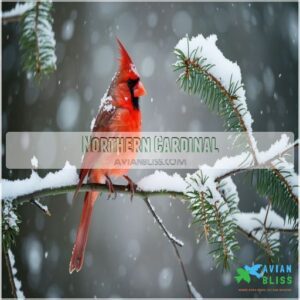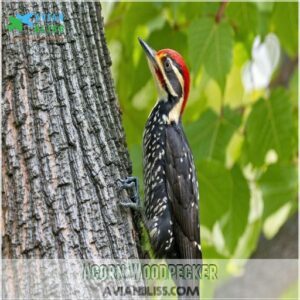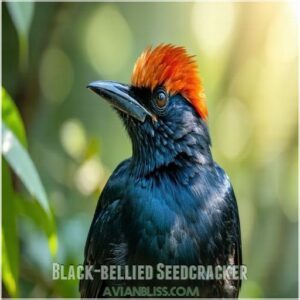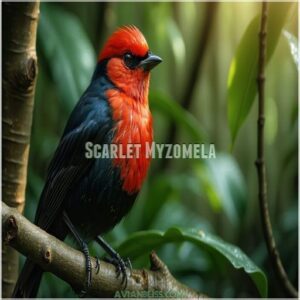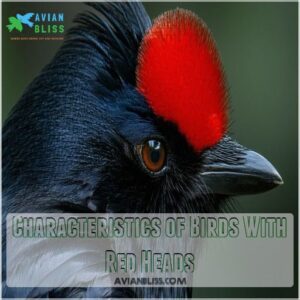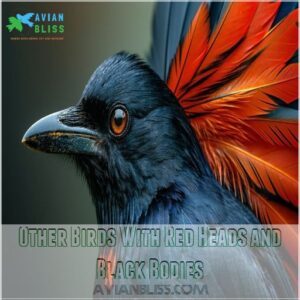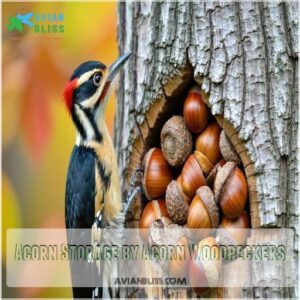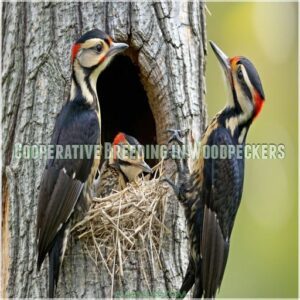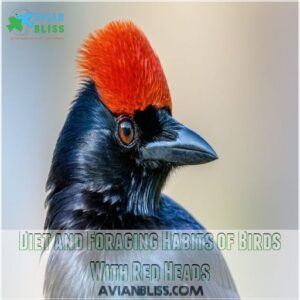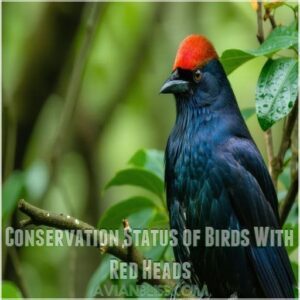This site is supported by our readers. We may earn a commission, at no cost to you, if you purchase through links.
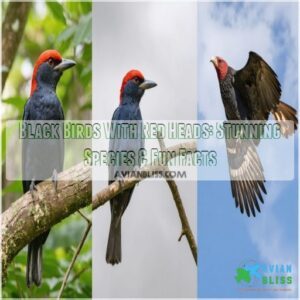
The Red-headed Woodpecker is an impressive example, showcasing a bright red head and a sharp knack for catching insects.
Then there’s the Crimson-collared Tanager, adding a splash of color to tropical forests with its vibrant plumage.
In North America, Turkey Vultures sport a distinctive red, albeit featherless, head.
These birds often gain their striking head color from diets rich in carotenoids.
Whether they’re acrobatically hunting insects or marking their territory, these birds stand out for their adaptability and bold behaviors.
Curious about their fascinating habits? Stay tuned!
Table Of Contents
- Key Takeaways
- Types of Black Birds With Red Heads
- Characteristics of Birds With Red Heads
- Woodpeckers With Red Heads and Black Bodies
- Birds of Central and South America With Red Heads
- Hummingbirds With Red Heads and Dark Bodies
- Other Birds With Red Heads and Black Bodies
- Unique Behaviors of Birds With Red Heads
- Habitat and Distribution of Birds With Red Heads
- Diet and Foraging Habits of Birds With Red Heads
- Conservation Status of Birds With Red Heads
- Frequently Asked Questions (FAQs)
- Are black headed Red Birds common?
- What bird has a red head?
- What bird has a Red Wing?
- What birds are red and black?
- Are there any birds with red heads in the UK?
- What does a scarlet-headed blackbird look like?
- What kind of bird is black with a reddish head?
- Where are scarlet-headed blackbirds found?
- What does it mean if you see a Red-winged Blackbird?
- What is the difference between a blackbird and a grackle?
- Conclusion
Key Takeaways
- You’ll discover that black birds with red heads are fascinating creatures found across various regions, showcasing incredible diversity in species like the Red-headed Woodpecker and the Crimson-collared Tanager.
- These birds’ vibrant red heads often result from carotenoid-rich diets, serving crucial roles in mating displays and territorial defense.
- Habitat loss poses a significant threat to these birds, emphasizing the need for conservation efforts to preserve their unique beauty and ecological roles.
- Red-headed black birds exhibit remarkable adaptability, thriving in environments from oak forests to tropical regions while facing challenges like climate change and resource competition.
Types of Black Birds With Red Heads
You’ll discover a surprising variety of birds sporting a striking combination of black bodies and red heads.
From the familiar Northern Cardinal to less-known species like the Black-bellied Seedcracker,
we’ll explore the fascinating world of these feathered friends.
Northern Cardinal
Spotting a Northern Cardinal is like finding rubies in your backyard—vivid red against black branches.
Known for cheerful cardinal songs, these red-headed birds are expert nest builders, using twigs and vine tendrils.
With molting patterns smoothing their feathers, they charm bird species enthusiasts.
Witnessing their winter survival skills or clever predator avoidance truly rounds out any bird identification adventure!
Acorn Woodpecker
The Acorn Woodpecker, a true marvel, stores acorns like treasure in granary trees, displaying incredible organizational skills.
Known for its cooperative breeding and tight-knit social structure, this bird thrives in oak and evergreen forests.
Its red head and black body make bird identification straightforward, showcasing a distinctive color splash in its habitat.
It’s a dynamic and amusing species!
Black-bellied Seedcracker
Imagine watching a black-bellied seedcracker, a fascinating bird species with striking red heads and adaptable behavior.
These birds, with their variable bills, feast on seeds and are a prime example of nature’s ingenuity.
Found in tropical environments, they face habitat threats but thrive due to their versatile diet and breeding habits. They’re an enchanting addition to your bird identification list. black-bellied seedcracker. adaptable behavior
Scarlet Myzomela
Meet the fierce Scarlet Myzomela, a tiny powerhouse among red-headed birds. Known for its territorial aggression, this vibrant species isn’t shy about defending its patch. It thrives in varied habitats, embracing the lush forests.
- Diet specifics: Feasts on nectar and insects.
- Nest building: Crafts delicate homes.
- Conservation concerns: Faces habitat loss.
- Bird identification: Subtle red and black hues.
Turkey Vulture
Turkey vultures, unlike our vibrant Scarlet Myzomela friends, possess a more somber charm with their black bodies and reddish heads.
As masters of the skies, these birds excel in gliding gracefully, sniffing out their next meal.
Vultures’ diets mostly consist of carrion, which makes them ecological cleaners.
| Feature | Description | Fun Fact |
|---|---|---|
| Diet | Carrion | Helps keep environments clean |
| Flight Patterns | Long glides | Rarely flaps wings |
| Social Behavior | Sociable groups | Known as ‘venues’ when roosting |
Characteristics of Birds With Red Heads
You might wonder why some birds sport such striking red heads, and it’s often thanks to carotenoid-rich foods in their diet.
These birds also tend to be quite bold, showing off their territorial nature during the mating season.
while easily adapting to different environments.
Red Plumage From Carotenoid-Rich Foods
Ever wonder how those vibrant red heads come to be? It’s all thanks to carotenoids! These pigments, found in certain foods, create the dazzling red plumage we admire in many birds.
The bird’s diet directly impacts feather color variation.
- Carotenoid sources include fruits and berries.
- Pigment distribution varies across species.
- Males often sport more intense colors.
- This bright plumage offers an evolutionary advantage.
- Studying bird diets helps us understand feather coloration.
Territorial Behavior During Mating Season
Territorial behavior during mating season is intense among birds with red heads.
Picture a red-headed black bird fiercely guarding its turf, squawking when other males approach.
This aggressive stance, driven by mate selection and breeding success, guarantees their nests are safe.
High aggression levels lead to successful nesting, with each bird fighting for its place in the bird breeding world.
Adaptability to Various Environments
Think of redheaded blackbirds as nature’s survival artists, thriving in diverse environments. Their adaptability is impressive:
- Resource Competition: They seek out new food sources.
- Climate Change Impact: Quickly adjust to temperature shifts.
- Habitat Loss Effects: Relocate deftly to suitable areas, often near water bodies where they can find products that support their adaptable lifestyle, such as those found in adaptable bird gear.
- Behavioral Adaptations: Innovate to avoid predators.
- Evolutionary Pressures: Evolve traits for survival.
These black birds with red heads are truly remarkable!
Woodpeckers With Red Heads and Black Bodies
You’ll find woodpeckers like the Red-headed and Pileated among the most striking birds with red heads and black bodies.
These birds are fascinating for their colorful looks but also for their amazing adaptations.
like creating elaborate nests and storing food for the future.
Red-headed Woodpecker
You can’t miss the striking Red-headed Woodpecker, a black bird with a vividly red head.
Found in open woodlands, these birds enjoy capturing insects mid-air—a true acrobat!
Their calls echo through forests, making them hard to ignore.
Sadly, habitat loss threatens their survival, but conservation efforts aim to protect these enchanting creatures, ensuring future generations hear their lively chatter.
Red-bellied Woodpecker
Shift your gaze from the Red-headed to the Red-bellied Woodpecker. This adaptable bird flourishes in diverse environments, similar to the Downy Woodpecker’s ability to cling to tree trunks while searching for insects like wood-boring insects.
- Red-bellied woodpecker habitat: Mostly oak and evergreen forests.
- Woodpecker diet: Enjoys insects, berries, and nuts.
- Nesting behavior: Known for excavating cavities in dead trees.
These enthusiastic drillers are a fine addition to nature’s concert!
Pileated Woodpecker
The Pileated Woodpecker, a showstopper in North American forests, is like the dapper cousin of woodpeckers. With its striking red crest and sharp call, it’s easy to spot flitting through trees.
Woodpecker enthusiasts can also show their love for this bird with unique Pileated woodpecker gifts.
These birds carve out massive, rectangular nests in decaying timber, providing homes for other creatures too.
Their diet includes insects, fruits, and nuts—talk about a sustainable diner!
Hairy Woodpecker
Among North America’s red-headed black birds, the Hairy Woodpecker stands out.
Its mostly white body, black and white markings, and that signature red patch atop its head make it easy to identify.
You’ll find these woodpeckers in various habitats, from forests to woodlands.
Their diet consists mainly of insects, but they also enjoy sap.
Hairy Woodpeckers are cavity nesters, excavating their own homes.
Conservation efforts focus on protecting their habitat.
Birds of Central and South America With Red Heads
In Central and South America, birds like the Scarlet-banded Barbet and the Crimson-collared Tanager bring vibrant splashes of red against tropical backdrops.
These birds create a visual spectacle that’s both enchanting and ecologically significant.
You’ll find these feathered marvels in lush rainforests, where they add life to the trees with their striking colors and unique behaviors.
Scarlet-banded Barbet
We’ve got the Scarlet-banded Barbet strutting its stuff with a red head that demands attention.
This red-headed bird species faces habitat loss, yet its vibrant calls echo in the canopies of the Amazon.
Known for their social behavior, these black birds with red heads play a key role, reminding us that conservation efforts matter.
Crimson-headed Partridge
You’ve heard of royalty in the bird world, right? The Crimson-headed Partridge wears its crown all year long.
Residing in Southeast Asia, this bird’s calm nature is mostly disrupted during the breeding season.
Notably, like the Pileated Woodpeckers’ red crests, the Crimson-headed Partridge’s crimson head makes it a stunning sight.
They prefer dense forests, feeding on seeds and small insects.
Conservation efforts are essential, as habitat loss poses a risk to these charming red-headed birds.
Red-headed Malimbe
The red-headed Malimbe is quite a character with its striking plumage and versatile diet.
This red headed black bird species thrives in diverse habitats across Africa.
You might hear their cheerful songs echoing through the trees.
Despite being rare, they’re not considered endangered yet. Still, keeping an eye on possible threats can help safeguard their future survival.
Crimson-collared Tanager
Switching from the Red-headed Malimbe, the Crimson-collared Tanager bursts into view with its vibrant red head and striking black body.
Found in Central and South America’s lush landscapes, this red-headed bird thrives on an insectivorous diet.
The crimson-collared tanager’s adaptability to various habitats makes it easy to spot for bird identification enthusiasts, despite facing threats from habitat loss.
Hummingbirds With Red Heads and Dark Bodies
You’re about to meet some remarkable hummingbirds with fiery red heads and shimmering dark bodies, like the enchanting Ruby-throated and Anna’s Hummingbirds.
These tiny marvels exhibit fascinating behaviors and unique adaptations.
These tiny marvels make them stand out in the avian world, not to mention their ability to buzz around as if they’ve had too much nectar!
Ruby-throated Hummingbird
Let’s zip over to North America’s only hummingbird with a red throat! The Ruby-throated Hummingbird is a tiny powerhouse.
Here’s what makes it special:
- Astonishing flight speed: Up to 30 mph!
- Intricate nest building skills.
- Clever predator avoidance techniques.
- Migration patterns spanning thousands of miles.
- A lifespan of around 3-5 years.
These tiny dynamos are a treat for birdwatchers!
Anna’s Hummingbird
Anna’s Hummingbird isn’t just a pretty face with its sparkling plumage; it’s a fierce competitor in avian life.
To attract these and other small birds with red heads like the Anna’s Hummingbird, consider selecting native plants.
You’ll be amazed by their shimmering flocks during migration and unique courtship rituals that include mid-air maneuvers.
These little birds hover to sip nectar and aggressively protect territories, making them a favorite for bird identification and ornithology enthusiasts.
Crimson Sunbird
Picture the Crimson Sunbird, a dazzling red gem in the treetops.
Known for its melodic song, this vibrant bird uses its long, curved bill to savor nectar and tiny insects.
Found across Asia and India, they’re masters of nest building.
Despite their beauty, habitat threats loom large. Conservation efforts are essential to safeguard these red-headed birds for future generations.
Other Birds With Red Heads and Black Bodies
You might think blackbirds with red heads are simply stylish, but they’re actually fascinating creatures with unique traits.
From the Little Vermilion Flycatcher to the Pine Grosbeak, you’ll discover amazing adaptations and behaviors that make these birds so enchanting.
Little Vermilion Flycatcher
Have you ever spotted a Little Vermilion Flycatcher flitting about? These tiny red-headed birds are a spectacular sight with their flash of vibrant colors. They’re often found perching elegantly, each like a tiny splash of paint on a canvas of sky.
- Breeding habits: Vulnerable, yet resilient
- Habitat loss: Major concern
- Predator threats: Constant vigilance needed
Common Redpoll
Ever spotted a little red gem flitting through the trees? That’s the Common Redpoll, an acrobatic black bird with a pop of red atop its head.
These red-headed birds aren’t shy about travel, migrating long distances for warmer weather.
With seeds as their fuel, they navigate changing environments, teaching us adaptability while facing conservation threats with tenacity.
Red Crossbill
The Red Crossbill is a fascinating bird with crossed mandibles, perfect for extracting seeds from cones. Imagine spotting one in your backyard with its vibrant red plumage. They display unique adaptations, such as ecological specialization in exploiting specific types of conifer species through cone specialization adaptations.
Here’s what makes them unique:
- Diet: Pine seeds are their favorite treat.
- Habitat: Coniferous forests across North America.
- Behavior: Known for forming lively flocks, especially when food is abundant.
Pine Grosbeak
Among several red-headed birds, the Pine Grosbeak stands out.
This sizable bird boasts a diet of seeds, buds, and insects.
You’ll find these birds in conifer forests across North America, Europe, and Asia.
Their breeding behavior involves building nests in trees. Migration patterns vary depending on the region and food availability.
Currently, their conservation status is of least concern; however, habitat loss remains a threat.
Identifying Pine Grosbeaks is fairly straightforward thanks to their striking appearance.
Unique Behaviors of Birds With Red Heads
You’re in for a treat with the fascinating behaviors of birds sporting red heads.
Acorn Woodpecker’s impressive acorn storage, which seems like nature’s own obsessive-compulsive case.
These woodpeckers also engage in unusual group dynamics such as mate-sharing and cooperative breeding, making them a delightful subject to study in the avian world.
Acorn Storage by Acorn Woodpeckers
Imagine this: Acorn Woodpeckers busily stockpiling acorns in cleverly crafted granaries.
It’s like their very own pantry, safeguarding supplies against hungry predators and harsh environments.
These industrious birds choose just the right acorns, considering environmental impact and social dynamics.
Their granary designs reflect practical mastery in bird behavior and habitats.
Now that’s putting survival instincts to work!
Mate-Sharing in Acorn Woodpeckers
Acorn woodpecker mating involves unique dynamics, often with mate-sharing that seems straight from a nature docu-drama.
It’s like a real-life reality show where infanticide rates and the dance of cooperative breeding play key roles.
Environmental factors shape these bird habitats, making each Acorn Woodpecker’s love life a balancing act of kin selection impact.
It’s bird behavior with a twist!
Cooperative Breeding in Woodpeckers
Ever wonder how woodpecker families work together? Cooperative breeding is their secret weapon. Here’s how it all shakes out:
- Woodpecker family dynamics: They share roles like nest building and chick feeding.
- Kin selection benefits: Help guarantee more of their genes survive.
- Environmental factors: Influence their breeding strategies.
- Breeding success rates: Teamwork boosts success, especially in tough habitats.
Habitat and Distribution of Birds With Red Heads
You’ll find birds with striking red heads and black bodies in diverse habitats ranging from the oak and evergreen forests of North America to the lush tropical regions of Central and South America.
These feathered wonders also thrive in the mountainous areas, showcasing their adaptability to different environments, much like humans choosing their favorite vacation spot!
Oak and Evergreen Forests
Although oak and evergreen forests might appear serene, they’re bustling with redheaded black birds busy with acorn production and bird migration. These habitats are rich in predator-prey dynamics, offering a bounty for both songbirds and predators.
Ensuring habitat preservation is essential to maintain these ecosystems, where redheaded blackbirds find their range and distribution.
| Aspect | Details | Impact |
|---|---|---|
| Forest Ecology | Diverse plant species | Supports varied wildlife |
| Acorn Production | Essential for many species | Boosts biodiversity |
| Bird Migration | Seasonal movement | Affects distribution |
| Predator-Prey | Natural balance | Controls population dynamics |
| Habitat Preservation | Essential for ecosystem health | Prevents species decline |
Tropical Regions of Central and South America
Imagine this: vibrant scarlet-banded barbets and crimson-collared tanagers flitting through lush rainforests.
Many red-headed, black-bodied birds thrive in Central and South America’s steamy jungles. These tropical regions offer perfect breeding grounds and diverse food sources.
Sadly, habitat loss threatens some, highlighting the need for conservation efforts to protect these stunning birds and their unique breeding behaviors.
Their migration patterns are less understood, but ongoing research helps us learn more.
Mountainous Regions of North America
In North America’s mountain regions, you might spot some intriguing black birds with red heads.
Elevation impacts their migration routes and habitat preferences, making these areas essential.
With conservation challenges like habitat preservation and climate change effects, birdwatching becomes a quest for mastery in understanding their range and distribution. conservation challenges
Keep an eye out for these wonders, appreciating their resilience and beauty. birdwatching black birds with red heads
Diet and Foraging Habits of Birds With Red Heads
You’ll find that birds with red heads have quite the appetite.
Their diet includes everything from insects to sweet nectar.
Whether they’re omnivorous woodpeckers or nectar-loving hummingbirds, their meals are as diverse as their habitats.
Omnivorous Diet of Woodpeckers
Woodpeckers have fascinating omnivorous diets fitting their agile nature.
From insects hiding under tree bark to juicy berries and nuts, woodpeckers enjoy a smorgasbord all year.
They expertly shift their menu with the seasons, showcasing impressive foraging techniques and adaptability. Red-headed woodpeckers, for instance, even savor the occasional frog.
Such dietary flexibility keeps them thriving through changing landscapes and climates. Dietary flexibility and foraging techniques are key to their survival.
Nectar-Feeding Hummingbirds
While zipping through gardens, red-headed hummingbirds, like the Ruby-throated, feast on nectar like it’s liquid gold.
These tiny acrobats rely on diverse nectar sources, including your own well-stocked hummingbird feeders.
By pollinating flowers, they play a key ecological role.
Yet, hummingbird migration and conservation threats pose challenges, making every drop of nectar count in sustaining these charming red birds.
Insectivorous Diet of Tanager
Tanagers truly spice up their diet with an insectivorous twist.
Imagine a shopping list that includes:
- Beetles for crispy delights.
- Caterpillars for a chewy snack.
- Spiders to liven things up with some eight-legged action.
- Ants for a zesty finish.
These red-headed black birds adapt their foraging strategies to meet changing nutritional needs throughout the seasons.
Conservation Status of Birds With Red Heads
When you think about birds with striking red heads, it’s important to think about the challenges they face.
Despite their vibrant appearance, many of these species encounter threats like habitat loss and climate change, making conservation efforts vital to their survival.
Threats to Birds With Red Heads
So, you’ve learned what these birds eat. Now, let’s talk about what threatens them.
Habitat loss, driven by human impact and climate change, is a huge problem, and finding the right Red-Headed Woodpecker Habitat products can be challenging.
Predation and disease also take their toll. It’s a tough world out there for a red-headed black bird!
Protecting their red-headed blackbird habitat is key to bird conservation. Their breeding success hinges on this. Their red-headed blackbird distribution is also affected.
Red-headed — Red-extended — Conservation
Every red-headed bird, including the charismatic Redheaded Blackbird, faces real threats like habitat loss and changing population trends.
Species such as the Red-Headed Woodpeckers are declining due to loss of dead trees in Wisconsin red birds in wisconsin.
Conservation efforts focus on improving breeding success and safeguarding habitats.
Imagine being a bird watcher and spotting these vibrant creatures is like finding a rare treasure.
Bird conservation isn’t just a hobby; it’s essential for preserving the enchanting beauty of these species.
Frequently Asked Questions (FAQs)
Are black headed Red Birds common?
Isn’t it funny how common black-headed red birds aren’t?
While you’ll spot red-headed birds with black bodies, like the Red-headed Woodpecker, black-headed red birds are rare in the wild, making each sighting a special treat.
What bird has a red head?
The Northern Cardinal is a striking bird with a bright red head.
Males boast vibrant plumage, thanks to their carotenoid-rich diet.
These colorful songbirds are common in backyard feeders, adding a splash of color to your garden.
What bird has a Red Wing?
Imagine a gleaming warrior with a bright shield, that’s the Red-winged Blackbird.
Its striking red shoulder patches adorn a glossy black body.
You’ll often find them near wetlands, boldly defending their territory with loud calls.
What birds are red and black?
Many birds sport red and black!
Think Northern Cardinals, their vibrant red a stark contrast to their black wings.
Red-headed woodpeckers are another great example.
There are also several tropical species with similar coloring.
Are there any birds with red heads in the UK?
Isn’t it peculiar that among the UK’s birds, you’ll spot the Great Spotted Woodpecker flaunting a striking red head?
These birds drum on trees.
They showcase their bold red and black plumage with flair.
What does a scarlet-headed blackbird look like?
A scarlet-headed blackbird flaunts a stunning crimson crown that starkly contrasts its glossy black body.
It’s a real standout among birds.
vibrant plumage, and enchanting with an audacious presence that demands admiration. A scarlet-headed blackbird is a real standout.
What kind of bird is black with a reddish head?
Curious about colorful creatures?
The Red-headed Woodpecker sports a striking scarlet crown atop a mostly black body.
These birds are charismatic tree-dwellers, busy storing acorns, snacking on insects, and occasionally enjoying berries.
Nature’s little hoarders!
Where are scarlet-headed blackbirds found?
Scarlet-headed Blackbirds, known for their striking appearance, are native to South America.
They add vibrant color to their habitats.
You’ll find them inhabiting wetland areas, marshes, and swamps primarily across Argentina, Paraguay, Uruguay, and southern Brazil.
What does it mean if you see a Red-winged Blackbird?
Spotting a Red-winged Blackbird means you’ve encountered one of the most widespread birds in North America, found in marshes and fields.
Their vivid shoulder patches symbolize territory defense,
echoing a tiny warrior’s spirit in bird form.
What is the difference between a blackbird and a grackle?
Blackbirds and grackles both belong to the icterid family, but they’re different.
Blackbirds, like the Red-winged variety, feature red shoulder patches.
Grackles are larger, have iridescent feathers, and distinct, piercing yellow eyes.
Conclusion
So, you’ve explored the fascinating world of black birds with red heads!
Did you know that over 20 species boast this striking combination?
From the acrobatic Red-headed Woodpecker to the vibrant Crimson-collared Tanager, these birds exhibit incredible diversity.
Their red heads, often a result of carotenoid-rich diets, play a role in mating displays and territorial defense. mating displays and territorial defense.
Remember, each black bird with a red head has its own unique story—a proof of nature’s vibrant artistry. nature’s vibrant artistry.
Keep exploring!

